At the TCUK 2015 conference, Rachel Johnston mentioned the idea of a content maturity model. We thought we’d take this idea and ask:
Could we develop a model that illustrates a hierarchy of needs for users of technical communication (and in particular, User Assistance)?
A model of what?
We suggest calling this model a technical communication user’s hierarchy of needs. This is because we’re considering the different points where a user interacts with technical communication content, the information they need, and value it gives to them.
It takes a similar approach to the content maturity model Rachel suggested (shown in the photo below), with the least mature organisations providing just the legal minimum, and most mature content systems contributing to branding and evangelism.
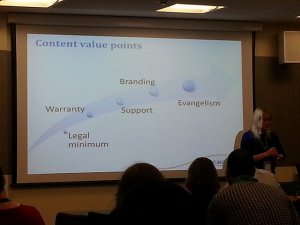
A user’s hierarchy of needs also enables us to compare this model to similar models from content marketing and product design. For example, the categories in our model’s hierarchy roughly correspond to Peter Morville’s “User Experience honeycomb”, as well as the key elements in product design.
A hierarchy of needs
The idea of a hierarchy of needs assumes what’s provided must meet the basic needs before it can satisfy higher-level needs, if it is to be successful. For example, organisations must enable users to complete tasks before they consider if the content is aesthetically pleasing.
At the bottom, we have the bare minimum – what’s required to avoid any litigation. As we move up the pyramid, we increase the utility, usefulness and aesthetics:
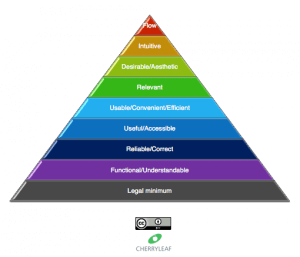
Mapping the hierarchy to technical communication products
We can connect this hierarchy to the different types of content we see in technical communication. We can also identify what the organisation needs to create if, for example, it wants its User Assistance to enable the product to be intuitive to users:
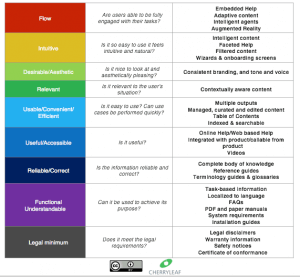
Integrating a technical communication user’s hierarchy of needs model with other content strategy models
We can also integrate this model to the Customer Journey Mapping model or the Customer Engagement model (Attract > Convert > Sustain > Advocate) to identify which technical communication deliverables an organisation will need at each stage of the customer engagement process. For example, if you want to sustain use of your product, you may need to make the User Assistance as intuitive as possible, and provide embedded Help.
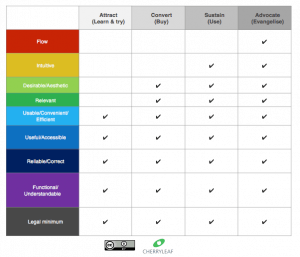
There are other models that could be integrated, such as the Technology Adoption Curve:
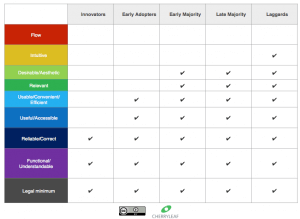
Innovators may be willing to accept a product that’s rough around the edges, with minimal documentation, in exchange for early access to the product. Other users will want and expect more.
Potentially, the model also could be mapped to personas, in order to identify which technical communication deliverables an organisation will be needed for each persona type.
Where there are currently ticks in the diagrams, you could list the specific technical communication deliverables required.
Share your thoughts
- Do you agree with the order of the technical communication user’s hierarchy of needs?
- Should anything have beeb added or removed in the hierarchy?
- Do you agree with the deliverables mapped to each level in the hierarchy of needs model?
Please share your thoughts below.

I think this model makes sense and I can see it being useful. Though I think it’d be most useful if it can be linked clearly to bottom-line value to a business – i.e. making a business case for moving up the hierarchy in a way that finance directors will find convincing.
Interesting to see the needs mapped against the deliverables – it looks about right.
I like the examples you’ve given of integrating with other models. Another good one is the Information Process Maturity Model (IPMM) as defined by Dr. JoAnn Hackos. This is great when considering the maturity of the technical communication department (and to some extent the wider organisation).
Picturing it in my mind’s eye, I think that integrating your model with the IPMM would be a particularly good combination. It’d show more clearly how internal maturity gains correlate with end-user benefits.
Perhaps I’ll get around to doing this myself!
Thanks Eric
I like the general idea here. I think the maturity can (should?) to be measured on several axes, perhaps something like clarity, consistency, findability, relevance (etc). — I suspect I’m half-remembering these facets from IBM’s Developing Quality Technical Information.
For example, your content might be accurate, complete, and branded well, yet it’s extremely difficult for users to actually find the information they need. Examples in the documentation could be rated on their relevance to users, on how easily they can be adapted for use, on how clearly they communicate the information being presented, on their visual presentation, etc.
I think such a model would be more actionable, because it would be easier to identify specific projects or tasks that would help move your content to the next level in terms of a specific facet rather than trying to address everything at once.
Acknowledgements should go to Maslow’s model of a Hierarchy of Needs: http://www.bbc.co.uk/news/magazine-23902918
Hi Diane
Abraham Maslow was the first person to suggest a hierarchy of needs, and it was something I studied on my degree in the dim and distant past. However, this hierarchy doesn’t really cover the same factors that Maslow was looking at. Also, Maslow’s hierarchy is disputed.Maslow certainly was my inspiration for displaying a hierarchy, but not more after than.
Thanks for raising it as an issue.